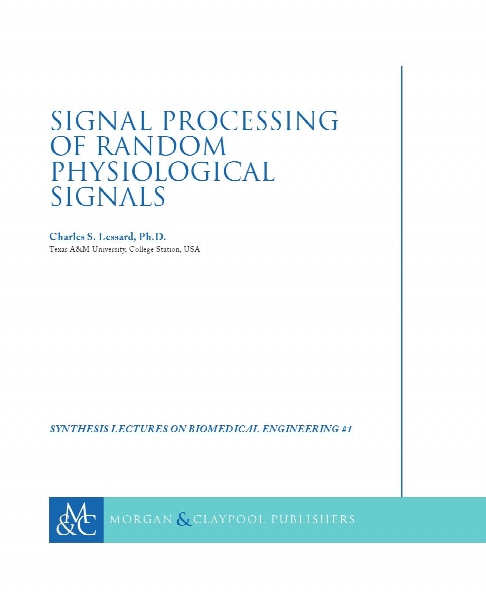Signal processing of random physiological signals
- نوع فایل : کتاب
- زبان : انگلیسی
- مؤلف : Charles S Lessard
- ناشر : [San Rafael, Calif.] : Morgan & Claypool Publishers
- چاپ و سال / کشور: 2006
- شابک / ISBN : 9781598290394
Description
Biomedical engineering signal analysis -- Introduction -- Generalized systems engineering approach -- System classification -- Order -- Causal vs noncausal -- Linear vs nonlinear -- Fixed vs time-varying -- Lumped parameter vs distributed parameter -- Continuous time vs discrete time -- Instantaneous vs dynamic -- Classification of signals -- How are signals classified -- Signal characterization (measurable parameters) -- Basis functions and signal representation -- Introduction to basis functions -- Desirable properties of basis functions --Evaluation of coefficients -- Signal representations -- Data acquisition process -- Data collection -- Data recording/transmission -- Data preparation -- Random data qualification -- Random data analysis -- Sampling theory and analog-to-digital conversion -- Basic concepts -- Sampling theory -- Quantization -- Digital format -- Signal reconstruction -- Digital-to-analog conversion (DAC) -- Stationarity and ergodic random processes -- Ensemble method to test for stationarity -- Extension-in-time method -- Review of basic parametric statistics and moment-generating functions -- Nonparametric statistic and the runs test for stationarity -- Review of nonparametric statistics used for testing stationarity -- Correlation functions -- The correlation process -- Properties of the Autocorrelation Function -- Steps in the autocorrelation process -- Numerical correlation: direct calculation -- Cross-Correlation Function -- Convolution -- Convolution evaluation -- Numerical convolution -- Convolution algebra -- Digital filters -- Classification of filters -- Digital filters -- Fourier series: trigonometric -- Fourier analysis -- Evaluation of the Fourier coefficients -- Equivalent form of the Fourier trigonometric series -- Symmetrical properties as related to Fourier -- Coefficients -- Euler expansion -- Limitations -- Limiting process -- Inverse Fourier transform -- Summary of symmetry tables -- Fast Fourier transform -- Continuous Fourier transform -- Discrete Fourier transform -- Definition of Sampling Rate (or Sampling Frequency) -- Cooley-Tukey FFT (Decimimation in Time) -- The FFT (3z(Bbutterfly(3y (Bsignal flow diagram -- Decimation-in-frequency -- Truncation of the infinite fourier transform -- Practical applications -- Spectral analysis -- Spectral density estimation -- Cross-spectral analysis -- Properties of Sspectral density functions -- Factors affecting the spectral density function estimation -- Advanced topic -- Window functions and spectral leakage -- Generalities about windows -- Performance measures -- Window functions and weighting equations -- Transfer function via spectral analysis -- Methods -- Autocorrelation -- The cross-correlation function -- Spectral density functions -- The coherence function -- Coherence function from spectral analysis -- Description of the coherence function -- Misapplication of the coherence function -- Examples of the use of coherence functions -- Problems that limit the application of coherence --Conclusion -- Error in random data estimate analysis (Information Is Paraphrased from Bendat & Piersol) -- Cross-spectral density function estimates.
This lecture book is intended to be an accessible and comprehensive introduction to random signal processing with an emphasis on the real-world applications of biosignals. Although the material has been written and developed primarily for advanced undergraduate biomedical engineering students, it will also be of interest to engineers and interested biomedical professionals of any discipline seeking an introduction to the field. Within education, most biomedical engineering programs are aimed to provide the knowledge required of a graduate student while undergraduate programs are geared toward designing circuits and of evaluating only the cardiac signals. Very few programs teach the processes with which to evaluate brainwave, sleep, respiratory sounds, heart valve sounds, electromyograms, electro-oculograms, or random signals acquired from the body. The primary goal of this lecture book is to help the reader understand the time and frequency domain processes which may be used and to evaluate random physiological signals. A secondary goal is to learn the evaluation of actual mammalian data without spending most the time writing software programs. This publication utilizes zDADiSPy, a digital signal processing software, from the DSP Development Corporation.
Title from PDF t.p. (viewed Mar. 14, 2006).
Title from PDF t.p. (viewed Mar. 14, 2006).


